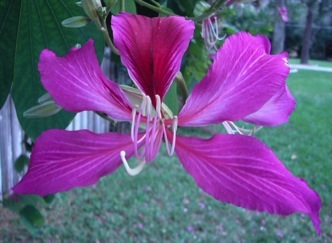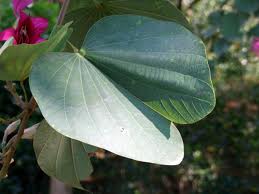Bauhinias’ Beauty
It’s called the Camel Foot Tree, the Cow Foot Tree, the Mountain Ebony Tree, the Orchid Tree, and the Hong Kong Orchid Tree. I ignored it until one day my curiosity got the better of me, and I discovered another edible in my local landscape.
Why did I ignore it? Well, there are so many imported ornamentals in Florida it could be a time-consuming task to identify them all. Plus most of the ornamentals tend to be toxic. But this was a tree I had noticed many times in many place and when I saw a stand of them readily accessible I decided to key it out and put a name on it: Bauhinia. (bah-HIN-ee-uh.) More so, my friend and fellow forager Sunny Savage in Hawaii uses the flowers in salads.
At least nine Bauhinia have edible parts from nectar to seeds. B carronii, B. esculenta, B. hookeri, B. malabarica, B. purpurea, B. racemosa, B. retusa, B. tomentosa, B. variegata (white flowered.)
A native of India, it is a tropical tree to 40 feet. But it is also found in subtropical areas and I live exactly on the subtropical/temperate line. There are occasional frosts here and an established tree can take a few degrees of frost. Farther south — say 100 miles — it is a common and well-naturalized tree, and on the official pest list. That’s another reason to put it on the edible list: The tree is becoming common and that means plenty of food should one want it. The stand I saw was along a bike trail so access is not an issue.
World wide there are over 600 species in the genus. In the United States they are naturalized along the coastal area of California, Texas, Louisiana, and central Florida south, planted in Arizona, Georgia, Hawaii and Puerto Rico. It is also a favorite of India, Vietnam and China. In Hong Kong, where B. blakeana is endemic, it is a special of the local ecosystem. The tree was introduced into Florida before 1900. The edibility of the B. blakeana is not mentioned but it is thought to be a hybrid between B. vareigata and B. purpurea, both with edible parts.
The give away of the species is it’s distinct leaf, basically a circle with a clef on one end, giving it the appearance of a round, cloven hoof. Of course, it is planted for its five-petal flower resembling an orchid. When in blossom it is considered “staggeringly beautiful.”
The name Bauhinia is after two 16th century Swiss botanist, Jean and Gaspard Bauhin. Variegata (vah-ree-uh-GAH-tuh) is for white variations on the leaves, purpurea (pure-PURE-ee-a) is from Greek for purple and blakeana (blay-kee-AY-nuh) is named after Sir Henry Blake, British governor of Hong Kong from 1898 to 1903. He was an enthusiastic botanist who discovered the blakeana in 1880 near the ruins of a house on Hong Kong island. The flower appears on the flag and coins of Hong Kong.
Bauhinia seeds contain high amounts of linoleic and oleic fatty acids and low amounts of myristic and linolenic fatty acids.
Some identification guides:
B. purpurea usually flowers September through December;
B. variegata January to March while the tree is leafless;
B. tomentosa (toe-men-TOE-suh) has yellow blossoms;
Green Deane’s “Itemized” Plant Profile
IDENTIFICATION:
Semi-deciduous tree to 40 feet, spreading crown. Leaves alternate, long petiole, thin-leathery, simple, deeply cleft at apex, making two large rounded lobes; lower surface downy. Flowers are showy, fragrant, in clusters near stem tips, five petals, clawed, overlapping. Fruit a flat, oblong pod, to one foot with up to fifteen seeds.
TIME OF YEAR:
Young leaves in season, flowers and pods usually fall.
ENVIRONMENT:
Full sun to part shade, all soils.
METHOD OF PREPARATION:
B. variegata: Young leaves, young seeds, young seed pods boiled. Flower buds pickled, flowers cooked. Can be made into a chutney.






